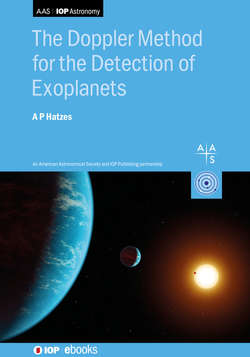Читать книгу The Doppler Method for the Detection of Exoplanets - Professor Artie Hatzes - Страница 22
На сайте Литреса книга снята с продажи.
2.1.4 The Blaze Function
ОглавлениеOne rather annoying feature of spectral data taken with echelle gratings is the so-called “blaze function.” The blaze function results from the interference pattern of the single grooves of the grating. Each facet is a slit, so the interference pattern is described by a sinc function.
Recall from optical interference that a smaller slit results in a broader sinc function.2 So, finely grooved gratings will produce a much wider blaze function. For a grating with rulings of ≈1000grooves/mm like the ones employed decades ago, the groove spacing is small, so the blaze (sinc) function is rather broad and was hardly noticeable, or at least easily removed. However, for echelle gratings that have wide facets, the blaze function becomes much narrower and the wavelength coverage larger such that the blaze function can become an issue in data reductions.
Figure 2.7 shows an extracted spectral order from an echelle spectrograph that has a strong blaze function. This should be removed for RV measurements. The blaze function can have an influence on your RV measurement in two ways. First, if you use the cross-correlation method (see Chapter 5), the blaze should be removed (flattened) from all extracted spectral orders before calculating RVs. As we shall soon see, the cross-correlation method matches two signals, and in this case it will simply be matching the blaze functions rather than the location of spectral lines.
Figure 2.7. A spectral order from an echelle spectrograph that has not been corrected for the blaze function. The blaze function is the interference pattern of a single groove and has the shape of a sinc function.
The second way the blaze function can influence the RVs is by altering the photon statistics after removal of the blaze. Note in Figure 2.7 that the number of counts at the edges of the spectrum are about half that at the center of the spectrum. This means that the signal-to-noise ratio (S/N) is a function of position along the spectrum, being a factor of 1.4 lower at the edges. If you normalize the spectrum in order to remove the blaze, the count rate in the continuum is no longer related to the true photon count. This will alter your statistics if you want to weight your RV measurement according to the S/N ratio.
Typically, the blaze function is not removed via the normal flat-fielding process (see below), so one needs to take an extra step in the reduction process to remove it. There are two approaches to doing this. One way to remove the blaze function is by dividing it with a low-order polynomial fit to the continuum points in your spectrum. This can be tricky as it depends on the choice of continuum points. As you see in Figure 2.7, it is sometimes difficult to identify the true continuum. This is particularly true for late-type stars with an abundance of spectral lines.
Alternatively, you can divide the blaze function with the spectrum of a rapidly rotating hot star with no spectral features. This has the advantage in that a hot star spectrum was taken through the same optical path as the science target. The disadvantage is that you are introducing additional noise, and for high-precision RV work, you not want to avoid increasing the noise level if possible. Also, there may still be stellar lines present in the hot star spectrum even though rapid rotation will make these shallow. These will alter the shape of the continuum.
